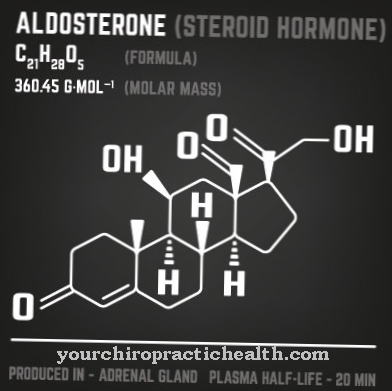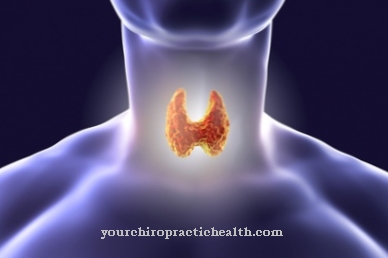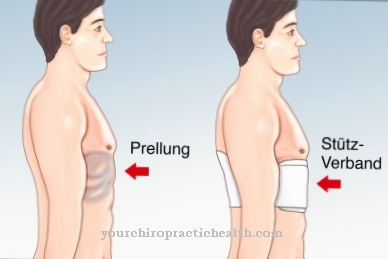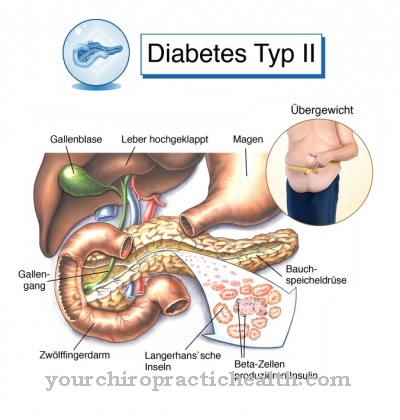At a Ulcer perforation it is a tissue destruction that affects all wall sections of an organ, so that a hole is created in the organ wall. This tissue destruction is caused by ulcers. The stomach or small intestine are most often affected by ulcers and thus also by ulcer perforations.
What is an ulcer perforation?
An ulcer is an ulcer. In most cases, it is an ulcer of the stomach or small intestine. A stomach ulcer is also known as Gastric ulcer, the intestinal ulcer will too Duodenal ulcer called. Even with one Ulcer perforation the type of perforation can also be distinguished. With a free perforation there is a continuous connection between the interior of the organ and the abdominal cavity. With the covered perforation, the hole in the wall is covered by neighboring organs and thus remains closed.causes
By definition, an ulcer perforation is always based on an ulcer. The causes of ulcers in the stomach and intestines are diverse. Many ulcers are caused by gastritis, an inflammation of the lining of the stomach. Nonsteroidal anti-inflammatory drugs (NSAIDs) such as ibuprofen, diclofenac or acetylsalicylic acid reduce the formation of mucus that protects the stomach. The aggressive stomach acid attacks the gastric mucous membrane and ulcers develop.
This cause is particularly tricky as the pain relievers also numb the ulcer pain. Even pronounced ulcers often go unnoticed by those affected. Toxic substances such as nicotine or alcohol also irritate the mucous membranes of the gastrointestinal tract. In addition, stomach ulcers can be the result of diseases such as hyperparathyroidism or Zollinger-Ellison syndrome. Stress can also lead to a stomach ulcer. The familial accumulation of the disease also indicates a hereditary disposition. The causes of the small intestine ulcer are similar to those of the gastric ulcer.
Symptoms, ailments & signs
Ulcer bleeding occurs in only about five to ten percent of all ulcer perforations. This manifests itself in the form of vomiting blood or spitting up blood. In either case, perforation of the ulcer creates an acute abdomen. The main symptoms include severe and sudden abdominal pain. The general condition is bad. The pain when a gastric ulcer is perforated is in the area of the epigastrium.
A perforated ulcer in the small intestine usually causes pain in the right upper quadrant of the abdomen. The pain is often accompanied by vomiting. The abdominal wall shows a reflex defense tension. The stomach is as hard as a board when touched. In addition, the entire abdomen is swollen. There may also be a fever.
Diagnosis & course of disease
Symptoms provide the first indications of ulcer perforation. Patients may report a history of pain in the stomach or intestines. A history of pain relievers also indicates an ulcer and possible perforation.
The anamnesis is followed by palpation and auscultation of the abdomen. The abdomen is hard and sensitive to pressure. If the severe inflammation has already led to a paralytic ileus, no intestinal noises can be heard through the stethoscope. Free fluid in the abdomen can be detected by means of an ultrasound examination. In addition, an X-ray of the entire abdomen is usually taken while lying down and standing. The chest is also x-rayed.
There is often an air sickle under the diaphragm. If the findings are still unclear despite these examinations, an esophago-gastro-duodenoscopy can be performed. The esophagus, stomach and duodenum are examined with an endoscope. The endoscope consists of a flexible tube with a video camera on top. This allows the condition of the organs and in particular the condition of the organ walls to be assessed.
If the ulcer perforation is not treated, it can cause inflammation of the peritoneum (peritonitis) and blood poisoning (sepsis). In peritonitis, a lot of fluid is lost through the peritoneum due to the inflammatory processes. Proteins also pass into the abdomen. Edema forms and, under certain circumstances, hypovolemic shock. Very high fever, rapid breathing, impaired consciousness, and shock indicate sepsis. Both conditions are life threatening.
Complications
An ulcer perforation causes an acute abdomen, which can cause various complications in the course of the disease. Typically, there are inflammations and abscesses in the abdomen, which, if the outcome is unfavorable, lead to sepsis. At the same time the general condition of the patient deteriorates and there is persistent pain in the affected area.
If the ulcer perforation occurs in the area of the small intestine, symptoms such as vomiting, intestinal obstruction and occasionally also high fever occur. In about five to ten percent of cases, an ulcer perforation causes ulcer bleeding. This is associated with vomiting of blood and can lead to anemia and the resulting complications. Surgical intervention can result in injuries to the tissue structures, infections, bleeding and secondary bleeding.
Wound healing disorders can also occur after an operation, which can have serious consequences due to the location of the perforation. If a catheter is inserted, there is a risk of inflammation. It can also lead to major injuries, which can be associated with sensory disorders and nerve damage. Medicines prescribed at the same time are always associated with certain risks and side effects.
When should you go to the doctor?
In the event of an ulcer perforation, the affected person is dependent on treatment by a doctor. This disease cannot heal itself, so treatment by a doctor must always be carried out. As soon as the first symptoms or complaints appear, a doctor should be consulted to treat the disease. As a rule, the doctor should be contacted if the person has vomited blood or if they spit up blood.
There is also very severe pain in the abdomen, so that the quality of life is also significantly reduced by this disease. In many cases, this can also lead to diarrhea or a fever, leading to the usual symptoms of flu. The ulcer perforation should be treated directly in a hospital. Therefore either call an emergency doctor or go to the hospital directly.
Therapy & Treatment
First, the wall defect is surgically closed. The damaged tissue is removed and the open areas are sewn over with healthy tissue. In addition, a so-called peritoneal lavage is carried out. The abdominal cavity is rinsed to remove the necrosis and any pathogens that may have entered. With peritoneal lavage, the abdomen is punctured with a large cannula in the area below the navel. Then body-warm Ringer's solution or saline solution is passed into the abdomen via a catheter. The rinsing liquid then runs back into the infusion bottle using the siphon principle.
prevention
Without an ulcer, there is no ulcer perforation. For prevention, it is therefore advisable to first omit all stomach-irritating food and drinks. Very spicy or very hot food as well as high percentage alcohol and coffee are not particularly well tolerated. To prevent a stress-related ulcer, relaxation exercises or stress management can be helpful.
Anyone who takes gastric-damaging medication for a long period of time (e.g. non-steroidal anti-inflammatory drugs) should discontinue these after consultation with the treating person or replace them with alternatives that are easier on the stomach. If the stomach lining is attacked by the bacterium Helicobacter pylori, it may be necessary to take antibiotics.
If there is a genetic risk, it may be advisable to take preventative acid blockers or proton pump inhibitors. If, despite all these preventive measures, an ulcer develops, it should be treated early or surgically removed. This is the only way to prevent perforation.
Aftercare
The breakthrough of an ulcer is a serious condition that requires consistent follow-up care. This depends closely on the location and is discussed with the general practitioner or specialist. In the case of gastric ulcers, the internist or gastroenterologist is the right contact for check-ups or the follow-up measures carried out by the patient.
In the case of a gastric ulcer, which will be discussed here as an example, gastroscopy is required at regular intervals determined by the doctor. Here, an ulcer can quickly be discovered as a recurrence and treated appropriately. Bacteria such as Helicobayter pylori, which can cause gastrits and, as a result, an ulcer, are also tracked down as part of this aftercare.
Nutrition is also of great importance after ulcer therapy. In this way, the diet must not burden the sensitive area even in the aftercare phase.Fatty and spicy dishes are to be avoided as well as acidic beverages, such as freshly squeezed orange juice.
Coffee lovers ideally limit their consumption in favor of herbal tea; still water is more recommendable than carbonated products. Alcohol and, above all, nicotine should be avoided, at least for the period of aftercare. Stress is often a factor in the development of an ulcer. That is why the reduction of stress factors as well as relaxation procedures and yoga are helpful in aftercare.
You can do that yourself
Ulcer perforation is a medical emergency. The most important measure is to contact the ambulance service. Until the emergency doctor arrives, the patient must lie down quietly and cool the affected area. After the wall defect has been surgically closed, rest and take care of yourself.
The affected area must be checked regularly, which is why a hospital stay takes place first. The patient should consult with the doctor during this time to determine possible causes of the ulcer perforation. Usually there is an ulcer that has to be removed. General measures may be useful. Changing diet and lifestyle will reduce the risk of ulcers and improve overall wellbeing. Sport and physically strenuous work should be avoided in the first two to four weeks after the procedure.
The diet must be changed immediately after the operation. Patients need to consume plenty of fresh fruits and vegetables, whole grains, fish, dairy products, and legumes. The supply of high-quality proteins and vitamins optimally supports the body's regeneration process. The doctor who took on the treatment of the actual ulcer can name further measures.













.jpg)

.jpg)
.jpg)











.jpg)